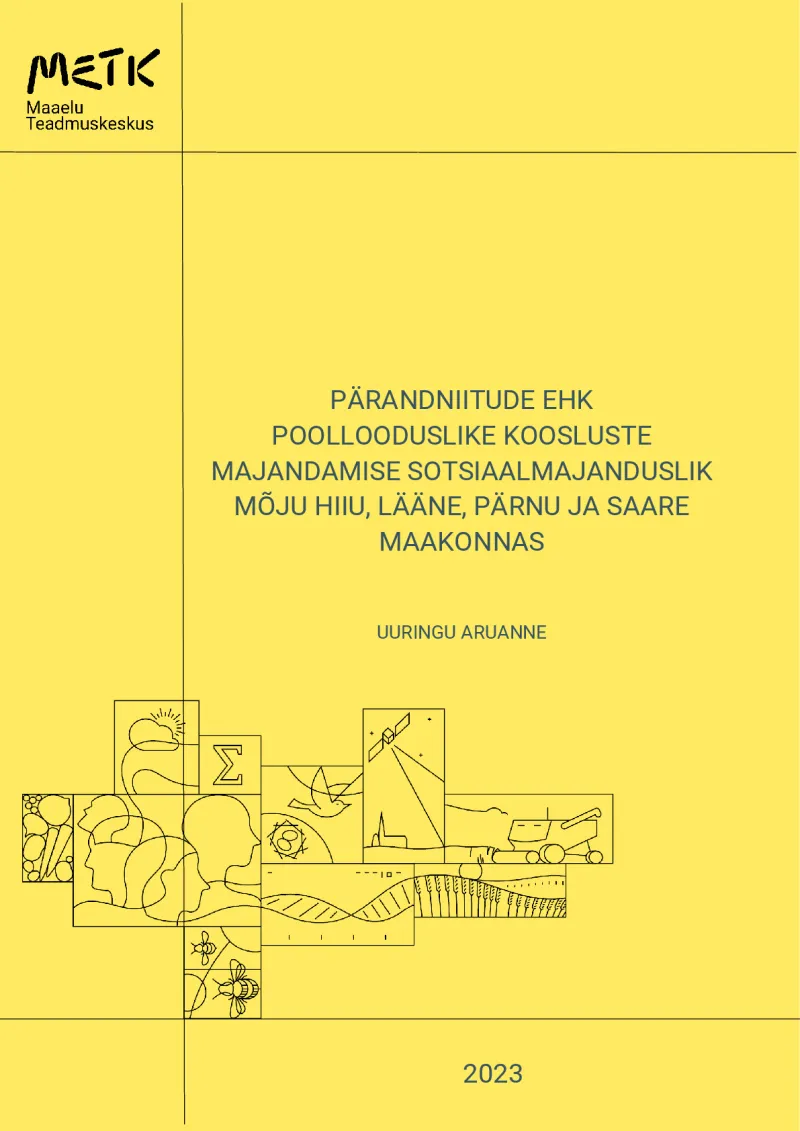The socioeconomic impact of the management of heritage meadows
Maintenance actions in semi-natural communities diversify rural life and their maintenance can be an important source of livelihood in rural areas.
- Estonia
- 2014-2022
- Socio-economic impacts

Heritage meadows (semi-natural habitats) are not only important from a nature conservation perspective but also have a significant socioeconomic impact. Maintenance of semi-natural habitats diversifies rural life and their maintenance can be an important source of livelihood in rural areas. The Estonian Rural Development Programme (RDP) has supported the maintenance of semi-natural habitats through various programming periods, implementing specific measures targeting these habitats.
The objective of the study was to gain an overview of individuals engaged in the maintenance of semi-natural habitats and their economic sustainability in areas less suitable for agriculture and peripheral regions, focusing on Hiiu, Lääne, Pärnu and Saare counties. It also analysed the impact of RDP support on the economic livelihood of farmers and the socioeconomic impact of managing semi-natural habitats in these regions. The study objectives were as follows:
- Describe the structure of farmers managing semi-natural habitats in Hiiu, Lääne, Pärnu and Saare counties.
- Analyse the impact of the companies/farmers managing semi-natural habitats in the area on the economy of the region (direct impact).
- Analyse the financial impact of the support paid for the maintenance of semi-natural habitats on the economics of the RDP beneficiaries' sustainability.
- Map the indirect economic factors related to the management of semi-natural habitats and analyse the impact on the region's economy (indirect impact).
RDP agri-environmental support for the maintenance of semi-natural habitats has a noticeable share in the incomes of both companies and self-employed persons and has a significant impact on the economic sustainability of companies engaged in the maintenance of the semi-natural habitats/heritage meadows, as well as the diversification of rural life and the development of rural entrepreneurship. When assessing the economic sustainability of the companies included in the sample taking care of semi-natural habitats, it was clear that various subsidies play a major role in the survival and operation of the companies: with subsidies, the share of sustainable companies was 61%, without RDP agri-environment support for maintenance of semi-natural habitats 49% and without taking any CAP subsidies into account, there were only 20% of sustainable companies. The importance of RDP agri-environment support for maintaining semi-natural habitats was highest among the beneficiaries in the islands, accounting for up to 12% of the total income. At the same time, sales revenue was also lowest in the islands. At the same time, the survey respondents mentioned that the support rate is too low and does not help with larger purchases for specific equipment or investments to maintain semi-natural habitats.
In addition to the economic aspect, according to the survey, the preservation of traditional landscapes and biodiversity, as well as the maintenance of ancestral lands, is an important motivation for managing heritage meadows in this region. This activity can be supported by RDP agri-environmental-specific support.
Slightly more than half of the RDP semi-natural maintenance applicants (54%) performed maintenance work on heritage meadows using unpaid labour. At the same time, the majority of RDP-specific support beneficiaries (83%) and non-beneficiaries (79%) answered that heritage meadows are maintained in full by themselves. In this case, it is customary not to count one's own salary, which is also confirmed by the survey results: two-thirds of the respondents who manage the heritage meadows independently do not pay wages to anyone (including themselves) for the maintenance work. Although, in many cases, the contribution of the maintenance work is not taken into account in the maintenance costs of the heritage meadow (they are not covered by a salary), then the interviewees were of the opinion that without subsidies, such areas would not be maintained due to the volume of the costly maintenance work. Therefore, RDP support for the maintenance of semi-natural habitats is crucial for the continued preservation of heritage meadows that are already under maintenance.
The survey revealed that, as a rule, the managers of the heritage meadows are not aware of the impact of their activities on the local area to the community and do not consciously try to contribute to it with its economic activities; the necessary production inputs are acquired primarily for self-sufficiency, not for the interests of the community. Land managers participate to a limited extent in projects and networks that promote the development of the region. Based on this, it is advisable to raise awareness among land managers of heritage meadows about the importance of maintaining these meadows and their wider impact on the regional economy and to consider the possibility of supporting the management of heritage meadows as a joint community activity.
Author(s)
Agnes Naarits, Marju Aamisepp, Eduard Matveev, Kristine Tiirats, Eneli Viik. Technical support: Marek Kärner (Maaelu Teadmuskeskus)